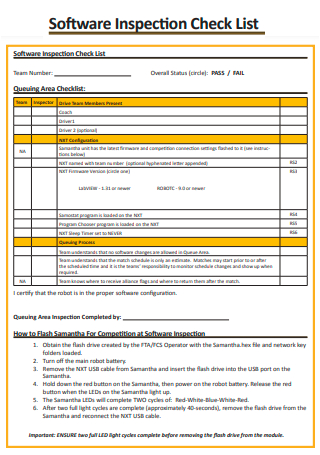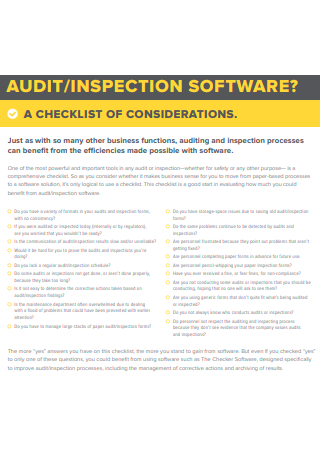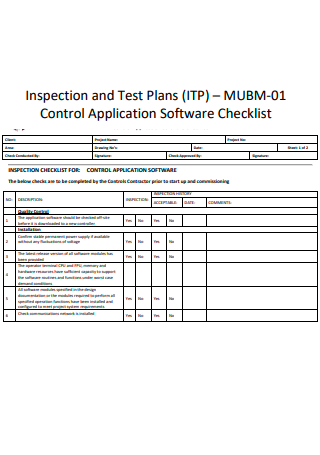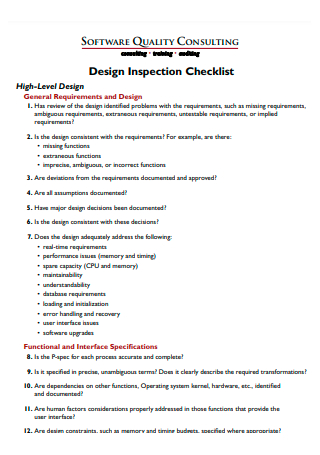3+ Sample Software Inspection Checklist
FREE Software Inspection Checklist s to Download
3+ Sample Software Inspection Checklist
What Is a Software?
The Software Development Process
The Software Inspection Checklist
FAQs
What is the purpose of a Software Inspection Checklist?
Who are the participants involved in the Software Inspection process?
What are the types of software testing done during the development process?
In this day and age, we found ourselves becoming more dependent on online solutions since it’s the fastest and convenient way of looking up a solution compared to the archaic ways of doing manual research work. Since we are living on a constant deadline, such as deadline for a report, deadline for a meeting presentation, deadline for a project, it is but natural we chose the fastest way to come up with information or solutions. A specific software profile can do all of that for us. But before a software can even be put to public, it has to go through a series of regulated processes. Most importantly, it has to go through proper inspection.
What Is a Software?
Webopedia defines software as a set of instructions, data, or programs used to operate a computer and execute specific tasks. In short, a software tells a computer how to function. It’s also known as software applications, scripts, and programs that run on devices such as PCs, mobile phones, tablets, and other smart devices. In contrast, a hardware is the physical equipment in which the software is built into, and is the one that actually executes the work as instructed by the software.
There are two types of software: the application software and the system software. An application software, or apps, is a software that executes a specific task for a specific purpose. Examples of application softwares are Microsoft Word, Adobe Photoshop, or even your downloadable mobile applications such as for photo editing, music, games, videos, et cetera. Whereas a system software is the one that is actually built into the computer and directs the performance of the hardware. It provides the basic functions of the computer. Examples of system software are your operating systems such as Microsoft Windows, macOS, Android, and Linux.
The Software Report released an article on the top 100 Software Companies for 2021. The selection was based on the criteria of software product quality, management team caliber, organizational culture and overall company evolution. Among the 100 chosen, the top five are: Microsoft, gaining the top one spot; Adobe, number two; ServiceNow, numberthree; Dropbox, number four; and IFS, as the number five placer.
Overall, the software industry has become the leading industry of our time. Even kids at a young age start to learn how to create and design software. The convenience the software provides fosters in an era where solutions can be found with a few taps on your mobile phone, making the world go faster than it already is. Businesses rely on the speed and accuracy of a software. Business owners apply application softwares in the movement and tracking of their business, or even in the accounting of their finances. Students utilized application softwares for their research and project presentations. In the entertainment industry, the softwares are used as a tool to boost an artist’s image and popularity. Also, you have popular software applications for recreation or amusement that’s trending around the globe, such as video sharing application TikTok, or social networking applications like Instagram, Facebook, or Twitter. Such is the impact of software that it has become a global force when it comes to logistics, solutions, connectivity and networking.
The Software Development Process
In today’s world, it’s hard to imagine any activity that’s not supported by a kind of software. As we’ve talked about, all industries have a software innovation behind it, or at least a software application that can support their operation. From industries such as finance, education, retail, also to almost every kind of lifestyle, everything is being supported by a software application due to the ingenuity of the creators behind the scene.
To develop a software takes a lot of practice and patience. You don’t necessarily have to be a computer science or computer engineering graduate to develop one, but you certainly need to have the patience and the commitment to go through such an undertaking. You have to be at least meticulous when it comes to developing, or as they say, programming a software, since a software is part and parcel of the whole package. If a code is inputted incorrectly, the whole structure itself collapses.
A software development is sometimes also called the Software Development Lifecycle. Stackify describes the Software Development Lifecycle as a process that produces software with the highest quality and lowest cost in the shortest time possible. SDLC provides a well-structured flow of phases that help an organization to quickly produce high-quality software which is well-tested and ready for production use. Just like your Product Development Lifecyle, PDLC, it simply means the process of creating a new product and introducing it into the market. When developing your software product, keep in mind what is the goal behind your software and who it’s supposed to be for, or what we call the end-users. Here are some of the basic process in developing a software.
The Software Inspection Checklist
Now that we have gone through the essentials of software development, it’s time to make that checklist to see if the software conforms to the standards set. As we’ve previously mentioned, inspection is not to be confused with testing. Software testing mostly involves tests conducted specifically on the functionality of the software and/or the correct coding. Software inspection is a form of documented quality control in which a team assesses the overall quality of the software, making sure it meets the pre-defined requirement. It is usually conducted by a team of programmers who follow a procedure in reviewing the source code with the intention of identifying defects and enhancing functionality and maintainability. It also provides recommendations as necessary.
A software inspection checklist is usually developed together by the quality control team. The inspection process goes through several stages such as: Planning, Preparation, Inspection Meeting, and Rework. The Planning stage is where the team meets to discuss the overall conduct of the inspection by the moderator. The Preparation stage is when the inspection of the software takes place. The Inspection Meeting stage is when the discussion of the software is taken up, and is gone through part by part, pointing out defects and areas for improvement. The Rework stage is where the developer takes action if there are necessary changes to be made after the inspection meeting. These are the common points usually found in a checklist during the software inspection stage:
Requirements
This is where the question of is the software requirements that were predefined are met. This includes the features and functionality of the software and if it was able to meet end-users’ expectations. It also identifies if the services that it was pre-suppose to provide was met, and also identifies the constraints on its operation.
Documentation
A software inspection also includes checking to see if proper documentation was in place. This documentation should consist of interactive end-use experience and the architecture, such as the Database architecture. The Database architecture documentation used should be incorporated in the code, the functionality of the application, and the notes that identifies what are the existing bugs and what actions have been taken to fix the bugs. Overall, the documentation should help you understand the software product, its interface, and its ability to fulfill a task.
Design and Code
Part of the inspection process is to ensure the right architecture and coding process is in place. You have your Database architecture. Inspecting the Database architecture is to make sure that the workflow process was followed. For the coding, the appropriate code was used when developing the software language to ensure end-user readability and usability experience.
Test Plans
Since part of the software development process is the software testing phase, it is also inevitable it will become part of the inspection process as well. The inspection team makes sure that the appropriate testings were conducted on the software. The test plans should include: the overall objective; the scope and approach on how the test will be conducted; the applications or components or codes to be tested; and the schedule and the resources that were allocated for the developers and for testers throughout the process.
FAQs
What is the purpose of a Software Inspection Checklist?
The purpose of the checklist is to guide the quality assurance team in looking for defects in the architecture and code programing, deviations, and to provide corrective action as necessary. It is to ensure that predefined requirements are met for the software development.
Who are the participants involved in the Software Inspection process?
The inspection process is led by a moderator, who is often the senior technical member of the inspection team. Then there is the author, who handles the software product that is going to be inspected. There is a reader, whose main job is to read the code and identify if there is any defect. Next is a recorder, someone who records or logs the inspection process. Last is the inspector. The inspector is the one who raises questions and objectively suggests solutions. Overall, the inspector is considered the critique of the group.
What are the types of software testing done during the development process?
There are lots of software testing to choose from out there. Overall, these are the three commonly used testing methods: Unit testing, which focuses on software unit design; Integration testing, which is to identify system or component compliance with functional requirements; and Regression testing, which is done to ensure that changes in the code should not have any impact on the existing functionalities.
New softwares, or software applications, are being developed constantly to solve everyday life’s challenges. They are very present in all types of industries and in all kinds of lifestyles. In fact, a world without any software application seemed almost unimaginable. We have all come to rely upon the convenience, speed and accuracy these applications provide. In fact, just the act of using our mobile phones already proves the powerful impact software has on our lives. But to create a software is no mean feat. You have to go through a rigorous and meticulous process in order to develop a software application. What ensures the success of a software is done by a good software inspection process with the use of a software inspection checklist.
Daunted by the idea of creating a software inspection checklist? We’ll help you out there. We have loads of software inspection checklists to choose from that’s ready for download. Check out our templates, and see how smooth and easy it is to create your own inspection checklist!




